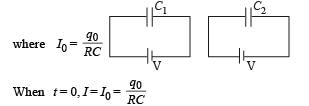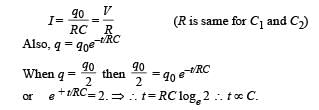JEE Exam > JEE Questions > Capacitor C1 of capacitance 1 micro-farad and...
Start Learning for Free
Capacitor C1 of capacitance 1 micro-farad and capacitor C2 of capacitance 2 microfarad are separately charged fully by a common battery. The two capacitors are then separately allowed to discharge through equal resistors at time t = 0.
- a)The current in each of the two discharging circuits is zero at t = 0.
- b)The currents in the two discharging circuits at t = 0 are equal but not zero.
- c)The currents in the two discharging circuits at t = 0 are unequal.
- d)Capacitor C1, losses 50% of its initial charge sooner than C2 loses 50% of its initial charge.
Correct answer is option 'B,D'. Can you explain this answer?
| FREE This question is part of | Download PDF Attempt this Test |
Verified Answer
Capacitor C1 of capacitance 1 micro-farad and capacitor C2 of capacita...
KEY CONCEPT : During decay of charge in R.C. circuit, I = I0e–t/RC

Since potential difference between the plates is same initially therefore I is same in both the cases at t = 0 and is equal to


or, t1 = 0.5 t2
Therefore time taken for the first capacitor (1 µF) for discharging 50% of initial charge will be less.

|
Explore Courses for JEE exam
|

|
Similar JEE Doubts
Capacitor C1 of capacitance 1 micro-farad and capacitor C2 of capacitance 2 microfarad are separately charged fully by a common battery. The two capacitors are then separately allowed to discharge through equal resistors at time t = 0.a)The current in each of the two discharging circuits is zero at t = 0.b)The currents in the two discharging circuits at t = 0 are equal but not zero.c)The currents in the two discharging circuits at t = 0 are unequal.d)Capacitor C1, losses 50% of its initial charge sooner than C2 loses 50% of its initial charge.Correct answer is option 'B,D'. Can you explain this answer?
Question Description
Capacitor C1 of capacitance 1 micro-farad and capacitor C2 of capacitance 2 microfarad are separately charged fully by a common battery. The two capacitors are then separately allowed to discharge through equal resistors at time t = 0.a)The current in each of the two discharging circuits is zero at t = 0.b)The currents in the two discharging circuits at t = 0 are equal but not zero.c)The currents in the two discharging circuits at t = 0 are unequal.d)Capacitor C1, losses 50% of its initial charge sooner than C2 loses 50% of its initial charge.Correct answer is option 'B,D'. Can you explain this answer? for JEE 2024 is part of JEE preparation. The Question and answers have been prepared according to the JEE exam syllabus. Information about Capacitor C1 of capacitance 1 micro-farad and capacitor C2 of capacitance 2 microfarad are separately charged fully by a common battery. The two capacitors are then separately allowed to discharge through equal resistors at time t = 0.a)The current in each of the two discharging circuits is zero at t = 0.b)The currents in the two discharging circuits at t = 0 are equal but not zero.c)The currents in the two discharging circuits at t = 0 are unequal.d)Capacitor C1, losses 50% of its initial charge sooner than C2 loses 50% of its initial charge.Correct answer is option 'B,D'. Can you explain this answer? covers all topics & solutions for JEE 2024 Exam. Find important definitions, questions, meanings, examples, exercises and tests below for Capacitor C1 of capacitance 1 micro-farad and capacitor C2 of capacitance 2 microfarad are separately charged fully by a common battery. The two capacitors are then separately allowed to discharge through equal resistors at time t = 0.a)The current in each of the two discharging circuits is zero at t = 0.b)The currents in the two discharging circuits at t = 0 are equal but not zero.c)The currents in the two discharging circuits at t = 0 are unequal.d)Capacitor C1, losses 50% of its initial charge sooner than C2 loses 50% of its initial charge.Correct answer is option 'B,D'. Can you explain this answer?.
Capacitor C1 of capacitance 1 micro-farad and capacitor C2 of capacitance 2 microfarad are separately charged fully by a common battery. The two capacitors are then separately allowed to discharge through equal resistors at time t = 0.a)The current in each of the two discharging circuits is zero at t = 0.b)The currents in the two discharging circuits at t = 0 are equal but not zero.c)The currents in the two discharging circuits at t = 0 are unequal.d)Capacitor C1, losses 50% of its initial charge sooner than C2 loses 50% of its initial charge.Correct answer is option 'B,D'. Can you explain this answer? for JEE 2024 is part of JEE preparation. The Question and answers have been prepared according to the JEE exam syllabus. Information about Capacitor C1 of capacitance 1 micro-farad and capacitor C2 of capacitance 2 microfarad are separately charged fully by a common battery. The two capacitors are then separately allowed to discharge through equal resistors at time t = 0.a)The current in each of the two discharging circuits is zero at t = 0.b)The currents in the two discharging circuits at t = 0 are equal but not zero.c)The currents in the two discharging circuits at t = 0 are unequal.d)Capacitor C1, losses 50% of its initial charge sooner than C2 loses 50% of its initial charge.Correct answer is option 'B,D'. Can you explain this answer? covers all topics & solutions for JEE 2024 Exam. Find important definitions, questions, meanings, examples, exercises and tests below for Capacitor C1 of capacitance 1 micro-farad and capacitor C2 of capacitance 2 microfarad are separately charged fully by a common battery. The two capacitors are then separately allowed to discharge through equal resistors at time t = 0.a)The current in each of the two discharging circuits is zero at t = 0.b)The currents in the two discharging circuits at t = 0 are equal but not zero.c)The currents in the two discharging circuits at t = 0 are unequal.d)Capacitor C1, losses 50% of its initial charge sooner than C2 loses 50% of its initial charge.Correct answer is option 'B,D'. Can you explain this answer?.
Solutions for Capacitor C1 of capacitance 1 micro-farad and capacitor C2 of capacitance 2 microfarad are separately charged fully by a common battery. The two capacitors are then separately allowed to discharge through equal resistors at time t = 0.a)The current in each of the two discharging circuits is zero at t = 0.b)The currents in the two discharging circuits at t = 0 are equal but not zero.c)The currents in the two discharging circuits at t = 0 are unequal.d)Capacitor C1, losses 50% of its initial charge sooner than C2 loses 50% of its initial charge.Correct answer is option 'B,D'. Can you explain this answer? in English & in Hindi are available as part of our courses for JEE.
Download more important topics, notes, lectures and mock test series for JEE Exam by signing up for free.
Here you can find the meaning of Capacitor C1 of capacitance 1 micro-farad and capacitor C2 of capacitance 2 microfarad are separately charged fully by a common battery. The two capacitors are then separately allowed to discharge through equal resistors at time t = 0.a)The current in each of the two discharging circuits is zero at t = 0.b)The currents in the two discharging circuits at t = 0 are equal but not zero.c)The currents in the two discharging circuits at t = 0 are unequal.d)Capacitor C1, losses 50% of its initial charge sooner than C2 loses 50% of its initial charge.Correct answer is option 'B,D'. Can you explain this answer? defined & explained in the simplest way possible. Besides giving the explanation of
Capacitor C1 of capacitance 1 micro-farad and capacitor C2 of capacitance 2 microfarad are separately charged fully by a common battery. The two capacitors are then separately allowed to discharge through equal resistors at time t = 0.a)The current in each of the two discharging circuits is zero at t = 0.b)The currents in the two discharging circuits at t = 0 are equal but not zero.c)The currents in the two discharging circuits at t = 0 are unequal.d)Capacitor C1, losses 50% of its initial charge sooner than C2 loses 50% of its initial charge.Correct answer is option 'B,D'. Can you explain this answer?, a detailed solution for Capacitor C1 of capacitance 1 micro-farad and capacitor C2 of capacitance 2 microfarad are separately charged fully by a common battery. The two capacitors are then separately allowed to discharge through equal resistors at time t = 0.a)The current in each of the two discharging circuits is zero at t = 0.b)The currents in the two discharging circuits at t = 0 are equal but not zero.c)The currents in the two discharging circuits at t = 0 are unequal.d)Capacitor C1, losses 50% of its initial charge sooner than C2 loses 50% of its initial charge.Correct answer is option 'B,D'. Can you explain this answer? has been provided alongside types of Capacitor C1 of capacitance 1 micro-farad and capacitor C2 of capacitance 2 microfarad are separately charged fully by a common battery. The two capacitors are then separately allowed to discharge through equal resistors at time t = 0.a)The current in each of the two discharging circuits is zero at t = 0.b)The currents in the two discharging circuits at t = 0 are equal but not zero.c)The currents in the two discharging circuits at t = 0 are unequal.d)Capacitor C1, losses 50% of its initial charge sooner than C2 loses 50% of its initial charge.Correct answer is option 'B,D'. Can you explain this answer? theory, EduRev gives you an
ample number of questions to practice Capacitor C1 of capacitance 1 micro-farad and capacitor C2 of capacitance 2 microfarad are separately charged fully by a common battery. The two capacitors are then separately allowed to discharge through equal resistors at time t = 0.a)The current in each of the two discharging circuits is zero at t = 0.b)The currents in the two discharging circuits at t = 0 are equal but not zero.c)The currents in the two discharging circuits at t = 0 are unequal.d)Capacitor C1, losses 50% of its initial charge sooner than C2 loses 50% of its initial charge.Correct answer is option 'B,D'. Can you explain this answer? tests, examples and also practice JEE tests.

|
Explore Courses for JEE exam
|

|
Suggested Free Tests
Signup for Free!
Signup to see your scores go up within 7 days! Learn & Practice with 1000+ FREE Notes, Videos & Tests.


















